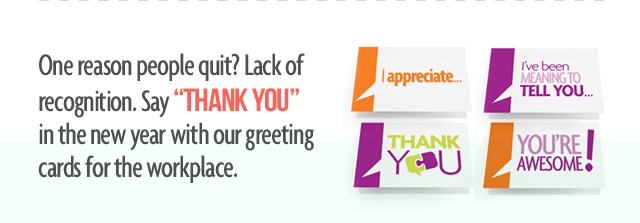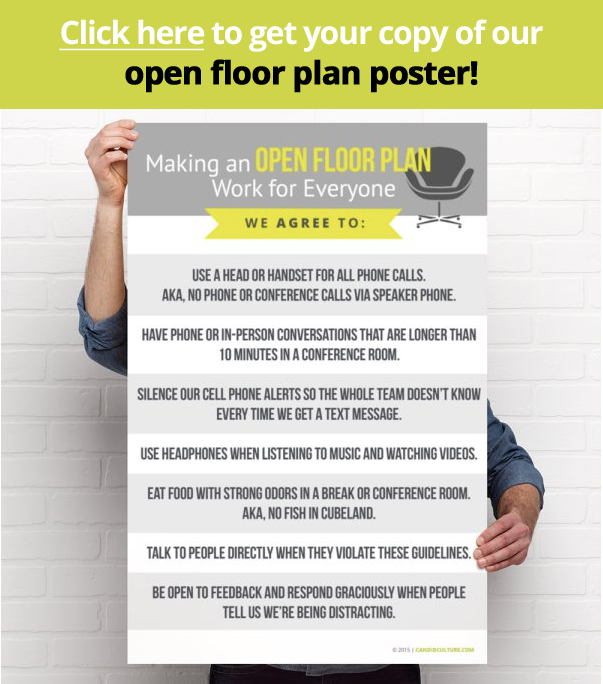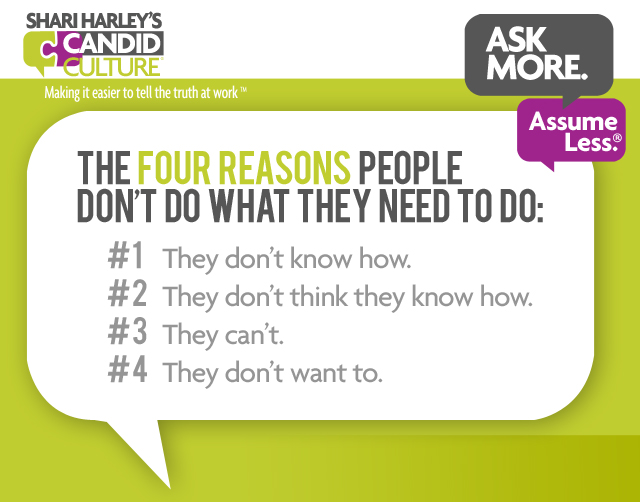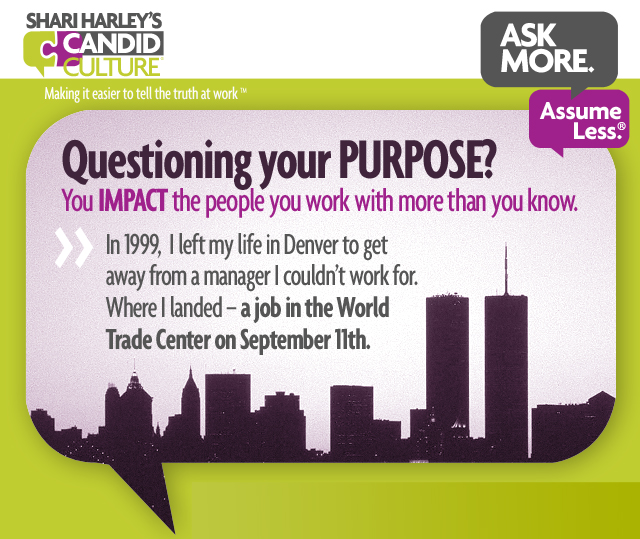Leading Organizations Archive

Several years ago I hired a vendor that wasn’t a good fit. Try as we might to work together, we didn’t communicate well. Everything was a struggle. After a frustrating few weeks, the owner of the business offered to refund my money and amicably part ways. His company had already done work on our behalf and I didn’t want to lose momentum. I turned him down. That was a mistake. When a small business owner, who needs your business (money), tells you to go elsewhere, listen. We parted ways a few months later in a much more costly and less amicable way.
You don’t want to work with people who don’t want to work with you. The same is true for friends and romantic relationships. Don’t chase people. If they don’t want you, move on. There are lots of other people who will see your value.
There are differing schools of thought on whether or not you should try to retain unhappy employees who quit. I’d be interested in seeing statistics on how long employees who quit but are then retained, stay with an organization and how well they perform. I’d let them go. Again, you don’t want people who don’t want you.
The challenge is that most people are afraid to speak up in organizations and relationships (of all kinds) when they’re unhappy. Unhappy employees typically quit versus make requests and give feedback.
The antidote is to create a culture in which employees, vendors, and customers openly make requests and talk about what is and isn’t working. Create a climate of candor in which feedback is exchanged regularly versus just during exit interviews, which is too late.
How to know when to cut bait with unhappy employees and vendors:
- You’ve had several open discussions and can’t meet each others’ needs. If you don’t have a job the employee wants, that’s a good reason to part ways.
- It’s not a good culture fit. You talk and talk but don’t communicate. Issues don’t get resolved. Frustration is the norm. This is also a good reason to end a working (or personal) relationship.
Five steps to create a more candid culture:
- Discuss employees’, customers’, and vendors’ needs and requests at the beginning of working relationships. Agree upon what success and a good job looks like. Ask lots and lots of questions, and listen closely to the answers.
- Ask for feedback regularly. Conduct a weekly plus/delta (a discussion of what is and isn’t working) during which all parties are invited and expected to speak freely. The more you have these discussions, the easier they will be and the more candid people will become.
- Address challenges as they come up.
- Discuss challenges that can’t be fixed.
- If a relationship isn’t working, end it sooner rather than later. Be slow to hire and quick to fire.
There are lots of talented vendors and employees. Find employees and suppliers who are easy to work with (for you) and who can meet your needs, and vice versa. If you can’t meet each others’ needs or the relationship is a constant struggle, those are good reasons to move on. Don’t chase.

 Every time I ignore the red flags I see when interviewing a candidate, or when I feel an employee is struggling, or a project is off track, I pay the price. Every single time.
Every time I ignore the red flags I see when interviewing a candidate, or when I feel an employee is struggling, or a project is off track, I pay the price. Every single time.
You interview a candidate whose commute will be 75-minutes each each way, but she says she likes to drive. Sure, until it snows. Move on. You haven’t gotten an update from a project team in over a month, but this group is typically reliable, so things are probably fine. Check in. Even the most diligent employees need accountability and attention.
They call them red flags for a reason. If you suspect a problem, there likely is one. Don’t just wait and ‘see how things go.’ Make a hard decision, get more information, or get involved. Wait and see is often a recipe for disaster.
Sometimes we don’t get involved because we don’t have the time or want to focus on other things. Other times we just don’t trust or listen to our gut.
Trust yourself.
I usually know what I want and need to do, both personally and professionally. Yet I tend to ask LOTS of people for their opinions of what I should do. I solicit advice from friends and colleagues, and in the end, I usually do whatever I want. Why not just trust that I know the right thing to do and just do it? Dad, are you reading this? See, I listen. My dad tells me all the time to stop soliciting opinions, I often ignore anyway, and just act.
Here are a six steps you can take to help listen to yourself and ensure you don’t overlook or ignore red flags:
1. Become very clear about your desired outcome. Decide what you want.
2. Eliminate distractions. Get quiet, aka, still your mind.
3. Think about the situation at hand. Weigh the facts and your options.
4. Decide without belaboring.
5. Act on your decision.
6. Don’t look back. Your initial decision is usually the right one.
Trusting and listening to ourselves can be hard. Perhaps it’s the fear of making a mistake or being wrong. Chances are you’re right. So pay attention to the red flags, trust yourself, and listen to your gut.
 Many organizations have moved from cubeland to open plan offices in which employees sit in rows of desks with no barriers between them.
Many organizations have moved from cubeland to open plan offices in which employees sit in rows of desks with no barriers between them.
There’s considerable research on the workability of open plan offices. Some of what’s written says that introverts do worse than extroverts in an open plan office. I disagree. I’d say that how a person learns/takes in information determines how well she’ll do in an open plan office.
If you’re a visual or kinesthetic learner who learns by seeing or doing, you’ll be less distracted by noise than an auditory learner who learns by hearing. Auditory learners hear everything and are easily distracted by talking, music, and other noise. Visual and kinesthetic learners often don’t hear distractions, so they do better in an open plan office.
Here are seven steps to make an open plan office a more productive environment:
- Schedule a meeting during which people sitting together can discuss the working environment they need to be satisfied and productive. Then facilitate a discussion during which the group creates 5 – 7 behavior guidelines each person agrees to follow when at their desks.
- Post the list of agreed-upon behaviors on a poster that is large enough to be read from any place in the work environment. Leave the poster up indefinitely.
- Give each person in the group permission to talk to individuals who violate the guidelines. This is very, very important. For the most part, employees won’t tell another person she is talking too loudly, eating food that smells, has too many visitors at her desk, listens to music or videos without headphones, or takes phone calls via speaker phone. People will suffer in silence and choose to work from home or in an empty office or conference room rather than speak up about the behaviors that frustrate them. Ask the group to grant each other permission to speak up when guidelines are violated. Giving each other permission to speak up will make future conversations possible – difficult but possible. Without permission and these agreed-upon behaviors in place, people will suffer in silence or talk about each other, not to each other.
- Ask everyone in the work group to take feedback graciously, responding with “thank you for telling me,” rather than with defensiveness.
- Two weeks after making the list of guidelines, get the group together to review the list and make any necessary changes to it. Discuss behaviors that were omitted, aren’t realistic, and are realistic but aren’t being followed.
- Then follow up by facilitating a monthly conversation during which group members give honest feedback about which guidelines are being followed and which are not, and problem solve as a group. These conversations aren’t a chance to embarrass or call people out in a group setting. If one person is violating a guideline, that conversation should happen individually.
- You will need a strong facilitator for the group discussions. The facilitator must tease out people’s thoughts, while making sure no one gets blasted in front of the group. Don’t let concerns that you know exist be brushed under the rug. Group members must openly and regularly discuss what is and isn’t working about their work environment, or frustrations will build and unhappiness and dissension will ensue.
It’s not too late to put these practices in place, even with a group who has been sitting together for a long time. Just schedule the conversation and explain why you’re having it. People will be relieved and grateful.
Working in an open plan office is challenging. It requires good communication and compromise. Don’t wait for problems to occur and frustrations to build. Have a conversation today.

 Most hiring best practices tell you not to hire people like you, and instead create diversity in your workforce by hiring people different from you. And that’s sort of true. You should hire people with different skill sets, experiences, and ways of thinking. And you should hire people with a similar work ethic and values, or you will consistently be frustrated.
Most hiring best practices tell you not to hire people like you, and instead create diversity in your workforce by hiring people different from you. And that’s sort of true. You should hire people with different skill sets, experiences, and ways of thinking. And you should hire people with a similar work ethic and values, or you will consistently be frustrated.
Here’s what I mean: If you live to work and hire people who work to live, that’s a values difference. If your view of what is reasonable regarding expected hours worked is different from your employees, that difference will cause conflict. If, like in our company, you value open, candid communication, but your employees can’t or won’t speak honestly, that’s going cause frustration. And these values and practices won’t change. Trust me.
The question is how to identify candidates’ values and work ethic before you hire them.
Here are a five hiring tips to ensure you hire people who reflect your values and work ethic:
Hiring tips number one: Describe what it’s really like to work for you and your organization. Don’t sugar coat the bad stuff. Tell the truth. Candidates will find out eventually. If the negatives of the job are deal breakers, your new employees will leave anyway.
Hiring tips number two: Check references. I’m shocked at the number of hiring managers who don’t check references. You might think that references have been so well trained to say nothing incriminating, that making the call is a waste of time. This couldn’t be further from the truth. Be personable, make friends with the reference, ask innocent sounding questions, and references will tell you everything you need to know.
Hiring tips number three: Require candidates to jump through some hoops during the interview process. Ask candidates to invest time doing a little of the work they’ll do on the job (this is called a Practical Interview, something way too few hiring managers do) and observing people work in your office. If candidates aren’t willing to invest this time, cut them.
Hiring tips number four: Ask how many hours candidates want to work and candidate’s preferred work hours, and believe what they tell you. If someone wants to work 35 hours per week and your culture is 50 hours a week, no matter how much your new hire wants and enjoys her new job, she doesn’t want to work 50 hours a week, and won’t do so for very long.
Hiring tips number five: Don’t ignore red flags or your instincts. If you think, “I have some concerns, but let’s see. Maybe it will work out.” Run the other way. It won’t work out. You’ll end up cutting that employee after months of training and coaching, or s/he’ll end up cutting you. It’s faster, cheaper, and easier to wait to hire until you find the right person.
Hiring rule of thumb: Be slow to hire and quick to fire.


People like certainty. We feel more comfortable knowing than not knowing. Not having an answer is uncomfortable. And looking for answers requires work. But sometimes knowledge is the enemy and the death to innovation in the workplace. If we know how something or someone is, there isn’t much of a reason to look for different and possibly better answers. But sometimes we don’t know what we don’t know.
Companies want to be innovative, creative and agile. And that’s good. A lack of innovation is surely the route to long-term failure. For example, a company is at the top of its game. It sells a product that is better than everyone else’s and becomes complacent. Relying on its past success, the successful company creates nothing new for five years, while up-and-comers are creating better solutions. Before they know it, the successful company is obsolete.
On a smaller scale, but equally damaging to innovation in the workplace, is hiring and retaining employees who don’t regularly ask the questions:
- Why do we do this this way?
- Is there a better way to do this?
- What don’t we know that we don’t know?
If you want innovation in the workplace, you need to hire people who are curious and think critically.
People who are curious and think critically have a few key qualities. Curious and critical thinkers are:
- Secure
- Self-confident
- Coachable
- Not afraid to ask questions
- Not afraid to be wrong
Identifying these qualities in candidates is challenging. I’ve interviewed and hired many people who seemed quite self-confident and coachable during the interview process, but once they began working, it quickly became apparent that they were neither. If you want people who will execute an existing process that works, non-critical thinkers are effective employees. If you want people who will consistently challenge the status quo, you should let insecure and people lacking curiosity go, as soon as you see the signs.
If you want innovation in the workplace and want your organization to stay current and competitive you need to have employees who aren’t afraid to consistently ask the question “why. Incorporate status-quo busting questions into your meetings. Create rewards and recognize people who risk trying to fix a problem or create something new.
Train employees to ask these questions:
- Why do we do things this way?
- Why did this happen?
- What questions have we not asked?
- What would happen if we did _______?
As always, you get what you ask for. What are you asking for?

 There are three reasons people say “that’s above or below my paygrade” or “that’s not my job” –they don’t feel empowered to make decisions, they think they’re being unfairly compensated for the challenges at hand, or they aren’t particularly motivated (read lazy).
There are three reasons people say “that’s above or below my paygrade” or “that’s not my job” –they don’t feel empowered to make decisions, they think they’re being unfairly compensated for the challenges at hand, or they aren’t particularly motivated (read lazy).
“That’s not my job” (aka, I don’t do things that are outside of my job description) is a mindset, and if someone has it, I’d suggest not hiring that person. People who think they should only have to do what’s on their job description aren’t utility players, and your organization is likely too lean to afford employees who only want to perform in a narrow box.
“That’s not my job” can also be an outcome of leaders and managers who can’t let go and let employees take risks and make decisions. If that’s your management style, hire people who will follow directions and don’t want to create new things and solve problems. Problem solvers will be frustrated if they only get to follow instructions.
Here are six steps to steer clear of “that’s not my job” syndrome and advance your career, regardless of your current role in your organization:
- Never say the words “that’s above or below my paygrade” or “that’s not my job.” Even if it’s true.
- If you don’t have the latitude to solve certain problems, ask the people you work for how they want you to handle those types of issues when you see or hear about them. That’s a subtle way to provide feedback that you don’t have the latitude you need to solve certain problems.
- When you see an impending train wreck, say something. I see lots of very capable employees see the train wreck coming, comment to themselves or others who can’t do anything about the problem (aka gossip), and then nod knowingly when the *&#@ hits the fan. Don’t be that person. Look out for your organization and the people you work with.
- If you see a broken or lacking process, raise the issue with someone who can do something about it, and offer to take a stab at fixing the problem. One of managers’ biggest complaints is employees who dump and run – “I’ve identified a problem. I’m leaving it for you to fix.”
- Go out of your way to do the right thing, even if you are uncomfortable or don’t want to. If it’s easier to email someone, but you know the right thing to do is to pick up the phone, pick up the phone. If an internal or external customer expresses concern and you can’t solve the problem, find someone who can. There are lots of ways to make an impact.
- Ask more questions. Find a non-judgmental way to ask, “Why do we do this this way?” “Have we considered…?” “Would you be open to trying…?” Status quo can be the right thing and what’s necessary. It can also be the death of organizations.
Make stuff happen. Don’t pass the buck. And if you are going to pass the buck, don’t announce it. It only makes you look disempowered and uncommitted.

 As crazy as it sounds, it can be difficult to get work done at work. There are the drive bys –people who want your opinion on EVERYTHING before they make decisions, the interrupters who have just one question, several times a day, the visitors who want to update you on EVERYTHING happening in their personal lives, and coworkers who host meetings at their workstation, take phone calls on speaker phone, and who listen to music without headphones, while loudly eating potato chips. All of these distractions are enough to make many employees want to find a quieter place to work.
As crazy as it sounds, it can be difficult to get work done at work. There are the drive bys –people who want your opinion on EVERYTHING before they make decisions, the interrupters who have just one question, several times a day, the visitors who want to update you on EVERYTHING happening in their personal lives, and coworkers who host meetings at their workstation, take phone calls on speaker phone, and who listen to music without headphones, while loudly eating potato chips. All of these distractions are enough to make many employees want to find a quieter place to work.
The concept that it can be hard to get work done at work is crazy. We’re at work to work. And yet many employees, with and without a door, get in at 7:00 am, before others arrive, so they can “get some work done” and stay late because they “got nothing done all day.”
Open work environments can be productive and interruptions can be minimized, but managing interruptions at work will require some clear guidelines and direct communication, which many workplaces are missing.
Managing interruptions at work – practices for creating a work environment that works for everyone:
Write workspace practices down, share them with all employees, post the practices in every work area, and discuss them frequently.
Examples of practices for managing interruptions at work:
- Use a headset for all phone calls.
- Pay attention to your volume. Speak as quietly as possible.
- If you have visitors at your desk for business or non-business related conversations that last longer than five minutes, take the conversation to a conference room, empty office, or local coffee shop.
- Use headphones to watch videos and listen to music.
- Avoid prairie dogging—calling down a row, hallway, or over a cubicle wall. Instead, walk to the person’s desk, call, or send an email or text message.
- Turn off all auditory alerts on computers and cell phones, so your coworkers don’t have to hear pinging and ringing all day. The people you sit with don’t need to know every time you receive an email, text, or Facebook message.
- Finally, but MOST IMPORTANTLY, give all employees permission to make requests and give feedback when workspace guidelines are broken. It must not only be acceptable but expected that employees will say something when a guideline is broken and the workspace gets too loud.
Most employees will not speak up when others are being loud. It’s easier to find another location to work than risk a coworker’s defensive response. And no one wants to be ‘that person’ who complains about how loud someone is. If employees aren’t comfortable speaking up and making requests, offer training on how to have these conversations, and provide written examples of what employees can say that is respectful and clear.
Guidelines for dealing with interruptions at work:
You’d think that having a door would make people immune to work place distractions, but that’s not the case. Employees with offices also deal with drive bys and interruptions. The key to dealing with both is communication.
- Don’t wait for problems to occur. Anticipate challenges and talk about them before guidelines are broken. It’s much easier to make a request than to give feedback.
- Each time a new person joins a team, department, or workspace, ask everyone on the team to share their work-related pet peeves, how they like to communicate, and how they prefer to be interrupted. Everyone deals with interruptions, so you might as well express a preference. If you’d prefer people email you and ask when you have time for a quick question, make that request. If you’re ok with people interrupting you without notice, let people know. If you’re not distracted by noise, tell people. If you are, make that preference known.
People are too hesitant to speak up at work for fear of damaging relationships and hurting people’s feelings. The best thing leaders can do to improve the working environment (or any workplace challenge) is to set clear expectations, create opportunities to talk about how things are going, and make it ok to speak up.
Suffering at work is optional. Everyone is accountable for the work environment, and you won’t get what you don’t ask for.

Employees appreciate perks – good coffee, an onsite gym, concierge service, and workout classes. But none of those things motivate employees to stay with an organization. And no one will quit because a company doesn’t offer those perks.
I won’t tell you not to offer yoga classes or to get rid of your video games. Just know neither perk is resulting in employee retention.
There are really just a few things employees need to stay with your company and do good work. And if you do those things consistently, you’ll see your best employees stay and excel.
Here are a few employee retention ideas: 
Employee retention idea #1: Managers, get to know employees better. Ask what brought employees to your company, what would make them leave, what employees want to learn, and what type of work they really don’t want to do. And when it’s possible, remove responsibilities employees don’t want to do, and replace those tasks with things employees enjoy more. You can’t eliminate all aspects of a job that employees don’t like. But people won’t stay in a job for long that doesn’t let them do work they enjoy about 75% of the time.
Employee retention idea #2: Managers, meet individually with employees, twice a month, for at least 30 minutes, to discuss current and future projects. Give specific and balanced (positive and negative) feedback during each meeting. Even the most independent employees need regular feedback and one-one-one time with their manager.
Employee retention idea #3: Teach and coach employees, so they expand their skill set and approach challenges in new and different ways. Most employees want to learn and grow. Managers don’t have to do the training themselves, just ensure it happens.
Employee retention idea #4: Give employees exposure to the senior leaders in your organization. This includes: attending meetings where senior leaders are present; pitching ideas to senior leaders; and learning from people above the employees’ manager.
Employee retention idea #5: Give employees stretch assignments and the chance to learn new things. One of the greatest reasons for employee turnover is boredom and a lack of growth and development. You don’t need to rotate or promote someone to help them grow. Giving employees exposure to different departments and types of work will allow employees to expand their skill set.
Most employees want to work for a manager who cares about them, takes time to get to know them, and helps advance their career. These activities will take some time. They won’t take a lot of money. Perhaps have your next one-on-one at the foosball table or over espresso. But know that the time managers take with employees, trumps every perk, every time.


How many times have you been sitting at your desk wondering, “Why won’t he ___________ ?’ Perplexed, you talk with your buddy at work. The conversation goes something like, “I’ve got this person, and I can’t figure out why he won’t ______________.” Or perhaps you talked directly to the person, but after several conversations, he still hasn’t done what you asked him to do.
There are four reasons for a lack of employee performance and why people don’t do what you want them to do:
- They don’t know how.
- They don’t think they know how.
- They can’t.
- They don’t want to.
Reason number one for a lack of employee performance, they don’t know how, is the easiest to solve. People who don’t know how to do something need training, coaching, a mentor, a job aid or some other form of instruction. The hope is that with the right training and exposure, he will be able to do what you’re asking.
Reason number two for a lack of employee performance, they don’t think they know how, can be improved over time with patience and consistent coaching. You aren’t working with clean slates. Most people are recovering from or reacting to a past relationship or situation. If a person worked for a controlling manager who never let him make a decision or worked for someone who invoked punitive consequences for making mistakes, the person will be hesitant to make decisions. Hence why he does drive-bys on you, repeatedly checking in, but never pulling the trigger on anything.
If you work with someone who doesn’t think he knows what to do, but you know that he has the answer, encourage him to trust himself. When he comes to you for validation or approval, ask questions, don’t give answers. Tell the person you trust his judgment and encourage risk taking. Tell him that you’ll support his decision, even if it proves to be the wrong one. And encourage him to make the decision next time without consulting you. And then keep your word. If he makes the wrong call, you have to have his back and can’t invoke negative consequences.
Reason number three for a lack of employee performance, they can’t, is challenging but clear-cut. People who can’t do a task their brains aren’t wired for, will never do that responsibility well, regardless how much coaching, training, and assistance you provide. If you have repeatedly AND EFFECTIVELY, coached, trained, and provided support, remove that responsibility and give the person something he can do well. If that responsibility is a large part of the job, you have someone in the wrong job. It’s time to make a change.
Reason number four for a lack of employee performance, they don’t want to, is annoying but manageable. There are lots of reasons people don’t do things they don’t want to do. Those reasons include, but aren’t limited to, boredom, lack of buy-in as to why something is important, insufficient time, feeling like a task is beneath them, etc. If you’ve got someone who can but doesn’t want to do something, you can either take the responsibility away, incent him to do it, or give feedback EVERY TIME the task doesn’t get done.
Giving negative feedback isn’t fun for the giver or the receiver. No one wants to hear that he isn’t meeting expectations and most people don’t want to tell him. But the discomfort of receiving negative feedback EVERY TIME the person doesn’t do what he needs to do will create behavior change. He will either begin doing what you ask, quit, or ask for a transfer. Either way, your problem is solved.
The first step in getting people to do what you want them to do is to discover why they’re not doing what you ask. It’s impossible to appropriately manage employee performance if you don’t know why someone isn’t doing what he needs to do. And the person to ask why a responsibility isn’t getting done isn’t you or your buddy, it’s the person not doing the work. So get out of your head, leave your office, and go talk to the person not doing the work.
Here’s how to start an employee performance conversation:
“I’ve noticed you’re not doing ___________. Help me understand what’s happening.” Watch your tone, inquire from a place of genuine curiosity, and identify the reason he isn’t doing what he needs to do. Then you can intervene appropriately and hopefully get what you want.


What to say about September 11th, this year, didn’t come to me until I was standing in front of a client’s leaders, talking with them about retaining employees and what they could do to become an even better place to work.
Their office isn’t too far from Shankesville, PA, where flight 93 crashed on September 11th, so they seemed like the right group with whom to share my story. Then I decided that perhaps I should share it with you too.
I bought my first house in Denver in 1999 and went on vacation shortly after closing on the house. Right before I left, my manager told me he had too many direct reports and was putting a layer between us. I’d have a new boss when I came back from my vacation.
Two weeks later, I returned to my new manager and found her to be defensive, paranoid, and irrational – in short, impossible to work with. I did everything I knew to work well with her, calling on our HR department and the EAP counseling available to me, for help. Despite that I led communication skills training for the company and taught conflict resolution, I couldn’t work with her, and let my old boss know I’d be leaving.
I suspect he already knew my new boss wasn’t going to work out (I wasn’t the only person struggling to work with her), and offered me a position in our New York office. He told me that if after 90-days I wanted to return to Denver, I could. Ninety-days in New York with all my expenses paid or unemployment with no plan? The choice was clear. I went to New York and moved into my office in Tower Two of the World Trade Center, where I worked on September 11th.
I’m not proud of uprooting my whole life for a manager I couldn’t work with, and it’s not something I recommend others do. But it does demonstrate the difference one person can make. I never actually lived in that first house I bought. I accepted a permanent job in New York, but wasn’t ready to let go of my life in Denver. So I struggled with the decision of whether to stay in New York or return to Denver, for three years.
It’s normal to question our purpose and wonder if we make a difference. If you ask these questions, consider all the people you work with on a daily basis and how you impact their daily lives. We spend a huge portion of our existence at work, and how we interact with coworkers, customers, direct reports, and vendors impacts their happiness, or lack thereof, in a big way.
Don’t underestimate the difference you make when you smile at someone in the hallway at work, or don’t. When you thank someone for making your job easier, or don’t. When you take the time to teach someone a quicker way to do something, saving him countless of hours, or don’t. Regardless of your title and position in your organization, you impact the people around you in a huge way, every day.
During last week’s training in Pennsylvania, I talked about the four things essential to retaining employees.
Retaining employees –the four things employees need to be satisfied and engaged at work:
- I trust the leaders who run this organization.
- My opinion means something. I am listened to.
- I feel respected (by my manager). We have a good working relationship.
- My work is challenging and interesting. My career is going somewhere here.
If you’re a manager working on retaining employees, spend time with your employees. Ask questions about their career goals. Take the time to coach and give feedback. If you’re a senior leader committed to retaining employees, be visible. Walk around your office(s), addressing employees by name, and asking about their daily work. And if you’re not in a position of leadership, be easy to work with by keeping your commitments, being a short cut and providing information when you can, and offering to help employees who are overwhelmed. Retaining employees is not just a manager’s job. Every person we work with impacts our daily lives more than we know.





 Every time I ignore the red flags I see when interviewing a candidate, or when I feel an employee is struggling, or a project is off track, I pay the price. Every single time.
Every time I ignore the red flags I see when interviewing a candidate, or when I feel an employee is struggling, or a project is off track, I pay the price. Every single time. Many organizations have moved from cubeland to open plan offices in which employees sit in rows of desks with no barriers between them.
Many organizations have moved from cubeland to open plan offices in which employees sit in rows of desks with no barriers between them.
 Most hiring best practices tell you not to hire people like you, and instead create diversity in your workforce by hiring people different from you. And that’s sort of true. You should hire people with different skill sets, experiences, and ways of thinking. And you should hire people with a similar work ethic and values, or you will consistently be frustrated.
Most hiring best practices tell you not to hire people like you, and instead create diversity in your workforce by hiring people different from you. And that’s sort of true. You should hire people with different skill sets, experiences, and ways of thinking. And you should hire people with a similar work ethic and values, or you will consistently be frustrated.


 There are three reasons people say “that’s above or below my paygrade” or “that’s not my job” –they don’t feel empowered to make decisions, they think they’re being unfairly compensated for the challenges at hand, or they aren’t particularly motivated (read lazy).
There are three reasons people say “that’s above or below my paygrade” or “that’s not my job” –they don’t feel empowered to make decisions, they think they’re being unfairly compensated for the challenges at hand, or they aren’t particularly motivated (read lazy).
 As crazy as it sounds, it can be difficult to get work done at work. There are the drive bys –people who want your opinion on EVERYTHING before they make decisions, the interrupters who have just one question, several times a day, the visitors who want to update you on EVERYTHING happening in their personal lives, and coworkers who host meetings at their workstation, take phone calls on speaker phone, and who listen to music without headphones, while loudly eating potato chips. All of these distractions are enough to make many employees want to find a quieter place to work.
As crazy as it sounds, it can be difficult to get work done at work. There are the drive bys –people who want your opinion on EVERYTHING before they make decisions, the interrupters who have just one question, several times a day, the visitors who want to update you on EVERYTHING happening in their personal lives, and coworkers who host meetings at their workstation, take phone calls on speaker phone, and who listen to music without headphones, while loudly eating potato chips. All of these distractions are enough to make many employees want to find a quieter place to work.






